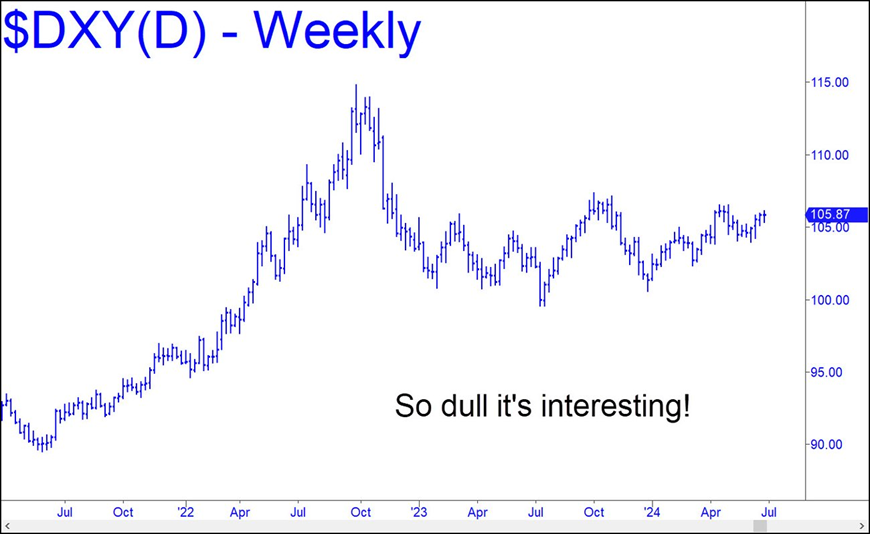Of all the markets tracked by Rick’s Picks, the dollar arguably has been the most interesting. This might seem paradoxical, given the relatively placid look of the Dollar Index chart above. Although there has been moderate turbulence since early last year, the overall impression is of a transoceanic flight cruising within a vertical range of several thousand feet. Most striking has been the dollar’s ability to hold aloft a mere 4% below 2022’s peak of around 115. This is tough to square with apparent reality, since the greenback’s global hegemony for the last 90 years has come under increasing challenge — from the BRICs, for one: Brazil, Russia, India, China, South Africa, Iran, Egypt, Ethiopia, and the United Arab Emirates. It were as though they had ganged up on the schoolyard bully, changing the way international trade in goods and commodities is settled so that dollars are disfavored in every meaningful way possible. Most recently, the Saudis announced with some fanfare that they would sell as much oil as demanded of them for payment other than in dollars. As the chart makes clear, however, if this had any discernible impact on greenbacks, it was to have caused their slight rise. Why the seemingly anomalous behavior?
A logical explanation is that global trade flows are but a relatively small portion of the uses to which dollars are put. The entire market for crude oil, for example, is estimated at around $2 trillion per annum. This may seem like a big number, but it is a pittance in comparison to the dollar sums that change hands in financial markets. There the tallies reach into the quadrillions of dollars — thousands of trillions, that is, if such numbers are even imaginable when tied to the flow of actual business. Compare that to global GDP of around $120 trillion, and you can see the futility of BRIC or anyone else trying to push the almighty buck around with threats scaled to the relatively meager volume of world trade in goods and services.
Does It Matter?
So many dollars are wanted and needed simply because it is the only currency that can handle the action of thousands of financiers all eager to bet untold millions of Other People’s Money on a roll of the dice. Do these mind-boggling sums matter? Some would argue that estimates that put the notional size of global derivatives markets as high as $2.4 quadrillion are just accounting fiction. They say the actual, gross value of all derivatives is closer to $15 trillion, and that anything higher than that requires a lot of double counting and loosey-goosey assumptions to quantify the financiers’ bets.
But anyone who saw the film ‘The Big Short’ or read the Michael Lewis book on which it was based will understand why it is the economists and bankers, with their conservative estimates, who have it wrong. In the movie, some big-time blackjack players are working huge piles of thousand-dollar chips purchased directly from the casino teller. But the boisterous crowd that has gathered around them are making side bets with ‘notional’ dollars aggregating into the many millions.
How Leverage Works
In the same movie, we are startled to learn that the derivatives market for insuring bonds is 20 times the size of the bond market itself. Does anyone actually believe that a crisis in the bond market would have no impact on all of the 20x money? Okay, it’s just a bunch of hedges. But when they unravel someday, as seems likely, it will wipe a very long string of zeroes from the global banking system’s balance sheet. And while the implosion may be a zero-sum game between borrowers and lenders, the money involved will be lost to both parties and to the banking system as a whole. Regardless of whether the sums were ‘gross’ or ‘notional’, they will never again buy a pearl necklace, a home in the Hamptons or a Ferrari.
Memo to the BRICs and other sovereign entities suffering from Dollar Derangement Syndrome (DDS): Trying to replace urgently wanted, and used, dollars with something else is a non-starter. It also raises the question whether we want to pay for all of our stuff, particularly energy, with super-hard money that is tightly tied to gold. That is a topic for another day.
Read the full article here

